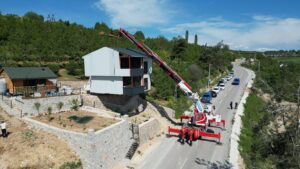Şanlıurfa recorded the highest total fertility rate in Türkiye in 2024, with 3.28 children per woman, according to newly released birth statistics from the Turkish Statistical Institute (TurkStat).
The southeastern province was followed by Şırnak with a fertility rate 2.62 and Mardin with 2.32. At the opposite end of the scale, Bartın and Eskişehir had the lowest fertility rates, each at 1.12, followed by Zonguldak and Ankara at 1.15 and Izmir at 1.17.
Türkiye’s overall fertility rate has remained below the population replacement level of 2.10 since 2017. While 57 provinces were under this level in 2017, the number climbed to 71 in 2024. Even more striking, the number of provinces with a fertility rate below 1.50 rose from just four in 2017 to 55 in 2024. Şanlıurfa is now the only province with a fertility rate above three, down from 10 provinces in 2017.
Compared with the European Union, Türkiye’s 2024 fertility rate of 1.48 births per woman ranked ninth among EU member states based on 2023 figures. The EU average was 1.38, with Bulgaria reporting the highest rate at 1.81 and Malta the lowest at 1.06.
A new classification introduced using the Spatial Address-Based Registration System (MAKS), which distinguishes between “densely urban,” “moderately urban” and “rural” areas, showed fertility was highest in rural areas at 1.83 children per woman, compared to 1.58 in moderately urban areas and 1.39 in densely urban areas.
Birth rate trends
The crude birth rate, representing live births per 1,000 people, declined from 20.3 in 2001 to 11 in 2024.
The age-specific fertility rate also shifted. In 2001, fertility peaked in the 20-24 age group with a rate of 144 births per 1,000 women. By 2024, the highest fertility rate was observed in the 25-29 age group at 100 per 1,000, indicating a shift toward later childbearing.
Teen births also dropped significantly. The adolescent fertility rate for women aged 15-19 declined from 49 births per 1,000 in 2001 to just 10 in 2024.
The average interval between a mother’s last two births increased slightly, from 4.6 years in 2019 to 4.7 years in 2024. Mothers who had their second child in 2024 did so an average of 4.3 years after their first. Those having a third child did so 5.4 years after their second.
Kırklareli had the longest average interval between first and second births at 5.4 years, followed by Çanakkale at 5.3 years and Kütahya, Edirne, Uşak and Bartın at 5.1 years. Şanlıurfa had the shortest gap at 2.7 years, followed by Şırnak at 2.9 years and Ağrı and Muş at three years.




















































Be First to Comment